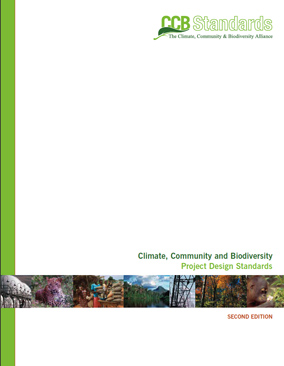New standards ensure forest carbon projects protect indigenous people, biodiversity
mongabay.com
December 8, 2008
|
|
The Climate, Community & Biodiversity Alliance (CCBA) has released its second edition of its CCB Standard for certifying land-based carbon offset projects.
“The CCB Standards provide a set of rigorous and verifiable criteria to determine the ability of a project to reduce greenhouse gas emissions while delivering lasting benefits for local communities and biodiversity,” said CCBA in a statement. “Independent third-party auditors verify that the project satisfies all required criteria, which demonstrate the project will mitigate climate change, conserve wildlife and natural ecosystems, and improve local livelihoods.”
The Climate, Community & Biodiversity Alliance is a partnership between leading companies, NGOs and academic institutions. Over 100 projects around the world are using the CCB Standards to improve project design. The World Bank, Merrill Lynch and EcoSecurities are counted among the carbon market investors using the standard.
“CCB certification assists market entry for projects with significant co-benefits by demonstrating their quality to buyers and, particularly in voluntary markets, attracting a price premium for the credits they generate. We see this as a good way to bring carbon finance to high-quality forestry projects and to boost investor and buyer confidence in the sector” said Jan Fehse, Head of Forestry Services at EcoSecurities.
 CCB Standards Second Edition |
“Forest carbon projects have great potential to generate new and improved livelihoods for many of the world’s poorer people as well as provide them with a means to tap the
emerging global carbon finance mechanisms including markets to fund their land stewardship activities. However, there are also significant threats to the rights of the
poorest and most vulnerable communities from these markets, so the CCB Standards are also extremely important as a means to safeguard and promote the interests of these often marginalized groups,” said Charles Ehrhart, head of the Climate Change Program at CARE International. “We have been impressed with the broad interest and participation in the revision process to produce an even more effective set of criteria for the new Second Edition.”
“We have been delighted with the rapid and broad uptake of the CCB Standards since the first edition was release in 2005,” added Toby Janson-Smith, the senior director of forest carbon markets at Conservation International. “It is clear they have played an important role in fostering the development of robust forest carbon projects that are helping mitigate climate change while conserving threatened species and improving local livelihoods throughout the developing world. The Second Edition has incorporated the lessons learned from three years of applying the Standards to further raise the bar. We expect this latest version to bring additional confidence to this important sector and to catalyze hundreds of millions of dollars of new carbon investment into multiple-benefit forest conservation and restoration activities around the globe.”
The CCB Standard includes a new ‘Gold Level’ for projects that “generate exceptional benefits by helping the poorer people of the world, by conserving sites of highest global significance for biodiversity conservation, or by providing significant support to assist with adaptation to the impacts of climate change.”
CCB Standards Second Edition